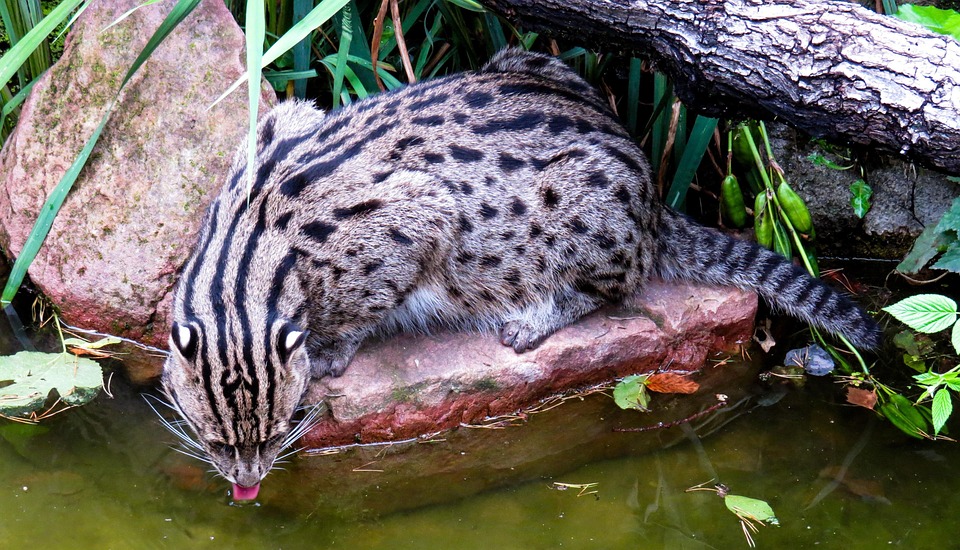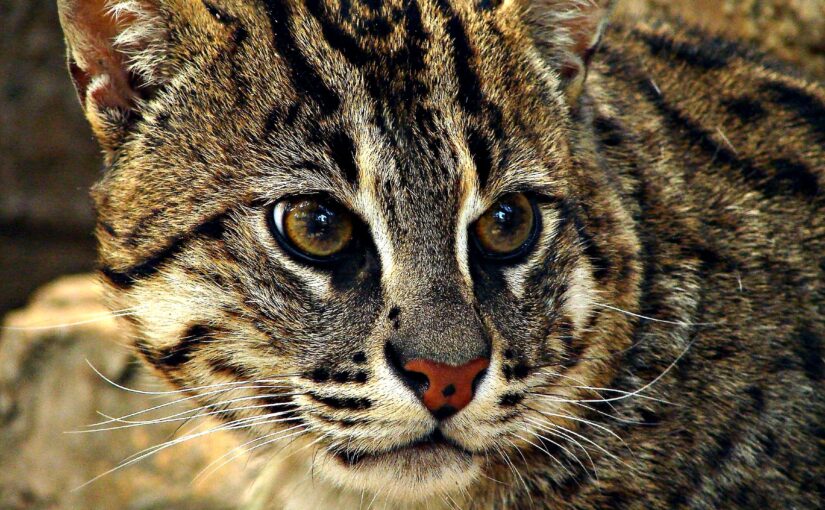When most people think of cats, one image comes to mind: a creature that loathes water, stepping gingerly around puddles and recoiling from the slightest splash. Yet in Asia’s wetlands, there lives a feline that defies this stereotype entirely. The fishing cat, Prionailurus viverrinus, is as comfortable in water as most of its relatives are out of it, moving sleekly through marshes and swamps with a confidence more reminiscent of an otter than a housecat.
Native to the wetlands of India, Nepal, Bangladesh, Sri Lanka, Thailand, and parts of Southeast Asia, as well as southern China, this unusual cat has evolved to make the most of aquatic life. It lives where rivers blend into backwaters, where mangroves sponge up seawater, and where reeds choke floodplains. These are rich but risky environments, and the fishing cat is perfectly suited to them.
Built for a Semi-Aquatic Life
Every part of the fishing cat’s body reflects its watery lifestyle. Its paws are broad, and the toes are partially webbed, acting much like flippers that help it paddle and strike with precision. Unlike most cats, its claws do not retract fully but stick out like hooks, ideal for snagging wriggling prey. Its skull is flattened, and its muzzle is broad, reducing drag when it pushes its head below the surface. Naturalists believe this is the same principle seen in its smaller cousin, the flat-headed cat, another wetlands hunter.
The fishing cat is stocky and muscular, with medium length legs and a powerfully built body for diving, swimming, and holding onto prey. Its head is wide with small rounded ears set low on the skull. The tail is short and thick, about one third to one half of the body length, and it acts as a rudder when the cat makes sudden turns in water.
Coat coloration aids in camouflage among reed beds and muddy waters. The fur is short and coarse, usually a grayish brown, patterned with dark spots on the flanks and shoulders. Several black stripes streak down the top of the head and neck, as many as eight of them in some individuals. The tail is encircled by black rings and ends in a dark tip. Its eyes shine with the deep gold of nocturnal readiness.

A True Angler
The fishing cat eats a variety of foods, but as its name suggests, fish make up much of its diet. Unlike a housecat halfheartedly pawing at a goldfish bowl, this cat is an expert angler. It wades into shallow water and plunges its head beneath the surface to catch fish directly in its jaws. It is also confident in deeper water, swimming strongly and diving when necessary. Shellfish, frogs, reptiles, and water birds are also taken, as well as rodents and snakes when the chance presents itself.
Observations of this specialized hunting technique reinforce its reputation as one of the most unique cats in the world. It often sits patiently at the edge of the water, ears twitching and eyes fixed, waiting for the telltale ripple of movement. With one swift lunge, it enters the water and secures its catch. In this way it is a true fisher among felines.
Size and Distribution
Fishing cats vary in size depending on region. In India, they can grow to around eighty centimeters in body length, not counting the tail, which adds a further thirty centimeters. Large males may weigh up to sixteen kilograms, making them robustly sized for a small cat species. In contrast, individuals from Indonesia are smaller, reaching only about sixty five centimeters in body length and weighing roughly six kilograms. This regional variation is one of the puzzles of their evolutionary adaptation and may reflect differences in prey availability and habitat.
Life Cycle and Reproduction
Much about the life of fishing cats remains unknown, partly because their watery habitats are difficult for researchers to access. What is known suggests a pattern similar to relatives of similar size. Females carry their young for sixty two to sixty four days, almost identical to the domestic cat. Litters are small, usually no more than two kittens, and mothers rear them alone in dense reed beds or hidden dens close to water. The young grow quickly, learning to navigate the waterlogged landscapes where stealth and swimming mean survival.
Conservation Status
Unfortunately, the fishing cat’s unique way of life is also its greatest vulnerability. It is entirely dependent on wetlands and marshlands, and these environments are vanishing at an alarming pace. Human communities have drained swamps for farmland, converted mangroves into shrimp farms, and built cities next to rivers and lakes. Overfishing further reduces the food available to fishing cats, pitting them in competition with people.
As a result, the species is in decline across its range. In Afghanistan it has already vanished. In Malaysia and much of China it may already be extinct. Where it remains, numbers are thin and habitats fragmented. Even in India and Nepal, where it is better known, the fishing cat is increasingly rare.
Loss of wetlands is not just a danger for the fishing cat. Wetlands act as nurseries for countless fish and amphibians, as stopover points for migratory birds, and as natural flood control systems for people. When fishing cats disappear, it is a warning sign that entire wetland systems are unraveling.
A Cat Full of Contradictions
The fishing cat is not showy like a tiger or as widely celebrated as a leopard, yet it holds its own kind of fascination. It is a cat that swims, a predator that thrives in a world where water and land blur. It embodies adaptability in a most unusual form while still reminding us of the fragility of specialized lives.
In captivity fishing cats show intelligence and curiosity but remain entirely wild at heart. In the wild they are rarely seen, their presence betrayed only by paw prints in the mud or by sudden splashes in the shallows. To see one emerge from the reeds, fur dripping and jaws clutching a fish, is to see nature’s imagination at work.
The fishing cat is a reminder that the cat family is full of surprises. Not all of its members are creatures of dry savannas or rocky mountains. Some, like this remarkable angler, are children of water. Protecting the fishing cat means protecting wetlands, which in turn means safeguarding countless other species, including humans who depend on the same ecosystems.
The image of a cat calmly wading through a moonlit swamp, whiskers twitching, ready to plunge into dark waters, captures its essence perfectly. The fishing cat is wild, resourceful, and unapologetically different, a feline that broke the mold and learned to master the world beyond the shore.
Teaser image by muzina_shanghai.
If you find joy in these tales of twitching whiskers and gleaming eyes, consider helping keep Whiskerito.com alive and purring. Your donation supports thoughtful research, engaging content, and the warm, wonder-filled community that makes this space what it is.
